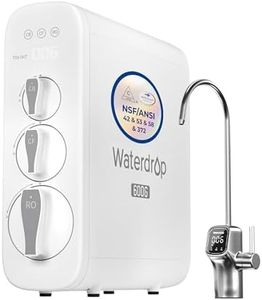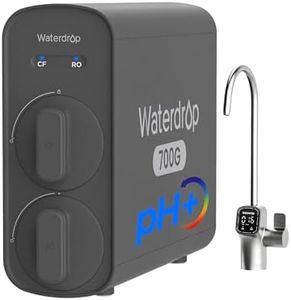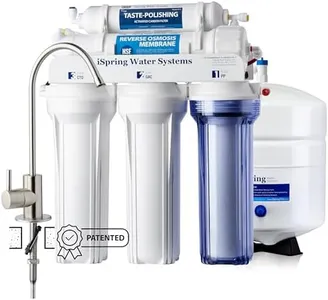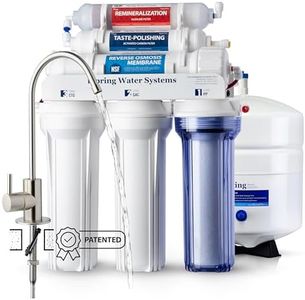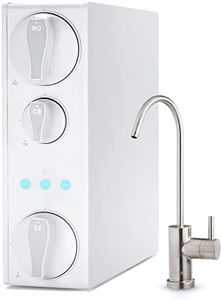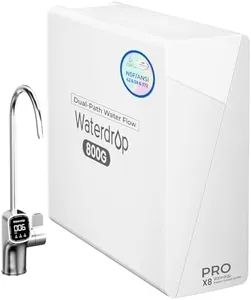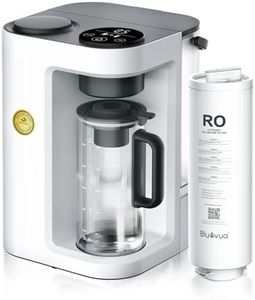10 Best Reverse Osmosis Systems 2026 in the United States
Our technology thoroughly searches through the online shopping world, reviewing hundreds of sites. We then process and analyze this information, updating in real-time to bring you the latest top-rated products. This way, you always get the best and most current options available.

Our Top Picks
Winner
Waterdrop G3P600 Reverse Osmosis System, 8 Stage Tankless Reverse Osmosis Water Filter, NSF/ANSI 42 & 53 & 58 & 372 Certified, Under Sink RO System, 2:1 Pure to Drain, Smart LED Faucet
Most important from
3651 reviews
The Waterdrop G3P600 Reverse Osmosis System is a robust choice for anyone seeking pure drinking water with its advanced 8-stage filtration process. It effectively reduces a wide range of contaminants including TDS, chlorine, heavy metals, and various chemicals, which makes it suitable for those concerned about water safety and quality. With a high water output of 600 gallons per day, it stands out particularly for large households or those who consume a lot of water daily.
One of its key strengths is its tankless design, which not only saves space under the sink but also allows for quick filling of water. The system boasts a low waste ratio of 2:1, meaning you get two cups of pure water for every cup of wastewater, making it more environmentally friendly compared to many other systems.
The smart display faucet is another impressive feature, providing real-time information on water quality and filter life, which simplifies maintenance. Installation is relatively straightforward, and changing filters is a breeze—no tools required. However, the G3P600 does have some considerations. It requires a power source, which might be a drawback for those looking for a completely manual system. Additionally, users need to ensure that their under-sink space is sufficient for the system, as it has specific size requirements. Lastly, while it provides excellent filtration, the initial cost might be higher than some basic systems, which could be a factor for budget-conscious buyers.
Most important from
3651 reviews
iSpring RCC7AK-UV, NSF Certified, 7-Stage Under Sink Reverse Osmosis Water Filtration System with Alkaline Remineralization and UV Filter, Patented Top-Mounted Faucet Design for Easy Installation
Most important from
20005 reviews
The iSpring RCC7AK-UV is a comprehensive 7-stage reverse osmosis water filtration system designed for under-sink installation. It effectively removes up to 99% of over 1,000 contaminants including harmful substances like lead, fluoride, arsenic, and PFAS, making it a strong choice for households concerned about water purity. What sets it apart is the addition of an ultraviolet (UV) filter stage that helps eliminate bacteria and viruses, making it suitable for well or less reliable water sources. The system also includes an alkaline remineralization filter that restores healthy minerals and improves water taste, addressing a common downside of typical RO systems that strip minerals out.
The system’s water output is moderate, with a maximum flow rate around 132 cubic centimeters per minute (roughly 1.9 gallons per hour), which may be slower than some users expect. It does not include a booster pump, so if your water pressure is low, you might need to purchase this separately. The clear first-stage housing makes filter checks easy, and the system is certified by NSF to ensure performance and safety standards.
The unit weighs 28 pounds and measures about 15" x 8" x 18", requiring decent under-sink space and some effort to install. Like many RO systems, it produces wastewater during filtration. Regular filter replacement is needed to maintain effectiveness, with frequency depending on usage and water quality. With its thorough contaminant removal, added UV protection, and mineral restoration, this model is a solid pick for users wanting cleaner, safer water from a trusted brand, especially if the water source might include bacteria or viruses.
Most important from
20005 reviews
Waterdrop X12-Alkaline Mineral pH+ Reverse Osmosis System, NSF/ANSI 42&58&372 Certified, 1200 GPD RO Water Filter, 11-Stage Filtration Tankless RO System, 3:1 Pure to Drain, UnderSink, BPA Free
Most important from
341 reviews
The Waterdrop X12-Alkaline Mineral pH+ Reverse Osmosis System is designed for those seeking high-quality drinking water at home. With its impressive 1200 gallons per day (GPD) filtration capacity, this tankless system ensures you’ll always have access to clean water without the wait. Its 11-stage filtration process removes a wide range of contaminants, including harmful substances like lead and fluoride, making it a solid choice for families concerned about water quality.
One of the standout features is its ability to infuse water with alkaline minerals, which can enhance the taste and provide health benefits. The smart digital faucet displays water quality and filter status, helping you manage usage and maintenance easily. Plus, the sleek, tankless design saves space under your sink and simplifies installation.
There are a few considerations to keep in mind. While the system boasts an eco-friendly 3:1 pure to drain ratio, the slight increase in total dissolved solids (TDS) due to the alkaline minerals may not be ideal for everyone. Additionally, filter replacement every 24 months might be less frequent than some users expect, but it could still pose a hassle depending on your usage and water quality.
Most important from
341 reviews
Buying Guide for the Best Reverse Osmosis Systems
Choosing the right reverse osmosis (RO) system for your home or business can be a bit overwhelming, but understanding the key specifications can help you make an informed decision. Reverse osmosis systems are designed to purify water by removing contaminants, making it safe and clean for drinking and other uses. Here are the key specifications you should consider when selecting an RO system, along with explanations to help you navigate through them.FAQ
Most Popular Categories Right Now


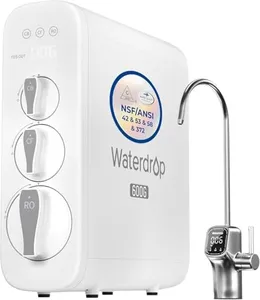
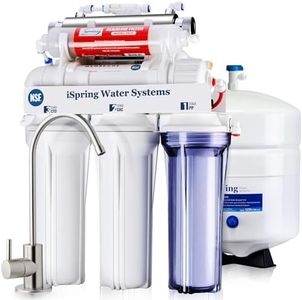
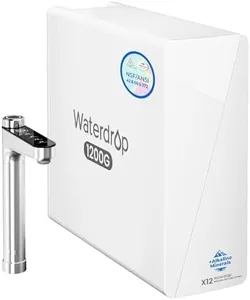
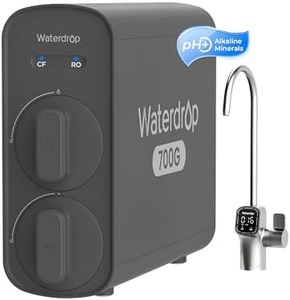

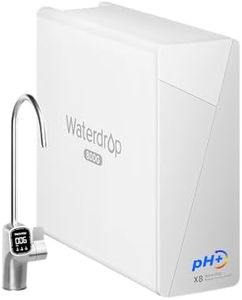
![[Dual Flow] Waterdrop WD-T4-A Alkaline pH+ Reverse Osmosis Water Filter, NSF/ANSI 372 Certified, 10-Stage, 450GPD Tankless Undersink RO Filtration System, 2:1 Pure to Drain, BPA Free, Plug-in required](https://images-proxy.bestreviews.guide/dj_aQ_y5oRQcKnoOW7GMBIxdfOY=/0x300/https://m.media-amazon.com/images/I/41quKiZO5BL._AC_CX679_.jpg)
